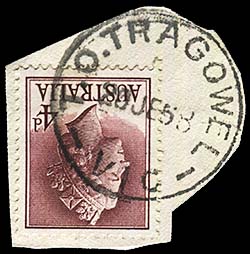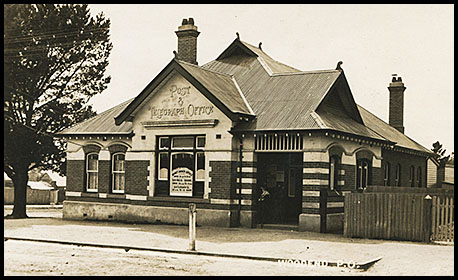Telegraph Offices on the Swan Hill line.
- Home, index, site details
- Australia 1901-1988
- New South Wales
- Overview of NSW
- Telegraph lines
- Telegraph Offices
- Date stamps
- Forms
- Envelopes
- Rates
- Stamps
- Queensland
- Overview of Qld
- Telegraph lines
- Telegraph offices
- Date stamps
- Forms
- Envelopes
- Rates
- Stamps
- South Australia
- Overview of SA
- Telegraph lines
- Telegraph Offices
- Date stamps
- Forms
- Envelopes
- Rates
- Stamps
- Tasmania
- Overview of Tasmania
- General developments
- Reports
- Organisation
- Telegraph lines
- Telegraph Offices
- Date stamps
- Railway lines
- Forms
- Envelopes
- Rates
- Stamps
- Overview of Tasmania
- Victoria
- Overview of Vic.
- Telegraph lines
- Telegraph offices
- Date stamps
- Forms
- Envelopes
- Rates
- Stamps
- Ephemera
- Western Australia
- Overview of WA
- Telegraph lines
- Telegraph Offices
- Date stamps
- Forms
- Envelopes
- Rates
- Stamps
A selection of some of the Post & Telegraph Offices on the Swan Hill line are shown below together with examples of date stamps used on telegrams.
|
The Office was created by renaming the office at Emberton in 1867. A Telegraph Office was also established at the Railway Station but this was closed in January 1922 and the duties absorbed into the Post Office. |
||
It appears that the office was issued with a T.O. Barfold date stamp although a strike has never been seen nor recorded. Instead, a date stamp with a space before Barfold - sufficient to accommodate T.O. - is recorded:
|
 5 November 1914. |
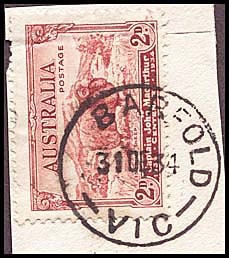 31 December 1934. |
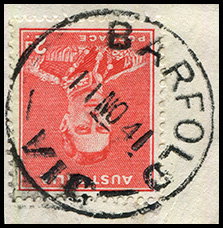 11 November 1941. |
||
| Castlemaine.
The Telegraph Office opened in January 1857.
The Castlemaine Railway Station served as a Telegraph Office from 1910 before being reclassified a a Post Office in 1915. It reverted to a Telegraph Office about 1940 and was closed about 1950. |
 Castlemaine P&T Office pre-1910. |
|
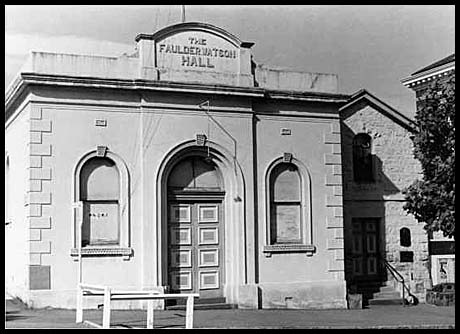 The original Telegraph Office used from 1857. Source: NLA jcoo4307. |
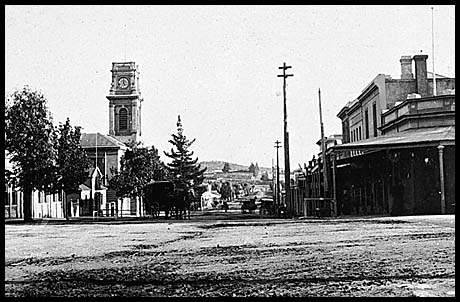 Castlemaine pre-1894 showing the P&T Office clock tower. |
|
 Castlemaine about 1870. |
 Castlemaine about 1899. |
|
A 1 hole Belt and Buckle date stamp was issued to the office.
|
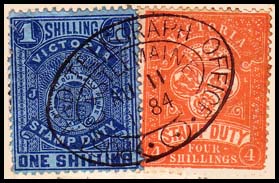 11 August 1884. Very rare use on 1/- and 4/- Stamp Duties. Provenance: Hugh Freeman, Johnstone. |
|
The usual postal date stamps were used on telegram forms. Both of the date stamps shown to the right were struck on telegram delivery forms. |
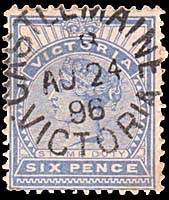 Unframed Castlemaine date stamp 24 August 1896. |
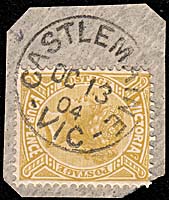 Framed Castlemaine date stamp 13 October 1904. |
|
Opened as a Post Office on 17 October 1927 and was reclassified as a Telegraph Office on 1 December 1942. The Office was closed on 10 June 1949. A steel circular date stamp for postal and telegraphic use is reported to have been used between 3 March 1933 and 30 June 1941. It is rated as RR. |
|
The date stamp shown here preceeds that early date by over 3 years.
|
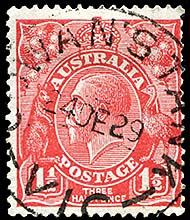 4 December 1929. |
| Dunolly.
The Telegraph Office opened in August 1859. |
Photographer: G. H. Jenkinson. |
| Glenalbyn (near Wedderburn).
The Post Office was established at Glenalbyn Railway Station on 20 January 1886 and was renamed Glenalbyn about 1910. The office was closed on 31 January 1973. |
A T.O. Glenalbyn date stamp was issued to the office:
|
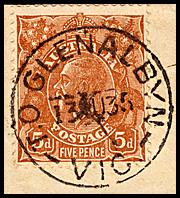 13 August 1935. |
|
|
|
|
Gold was first discovered at Inglewood in 1859 with a major find in 1860. The 1860 find caused the town to move slightly south and it was called "New Inglewood". In that year, Post Offices were opened at both Inglewood and New Inglewood. The Telegraph Office opened on 25 October 1861. |
|
In 1862, a fire destroyed the commercial precinct in New Inglewood. but it is not known if the Telegraph Office was destroyed. By 1865, about 40,000 people were in the town and the surrounding area. On 24 May 1880, the Bendigo Advertiser reported on the visit by a Ministerial party to Inglewood. "The hon, Mr. Bent, Commissioner of Public Works, accompanied by the Mayor and Borough councillors, visited the Post and Telegraph office, which was found to consist of a large commodious and rather neat looking wooden building and to the casual observer would seem to be all that was required in that direction by a town like Inglewood. But a great objection is that, not only does it swallow up considerable sum yearly of public money in repairs, but from its inflammable nature stands in great danger of being at any moment swept away by fire. In the event of such a calamity occurring, documents, etc., might be destroyed which no money could replace. This was laid before Mr. Bent and a suggestion made that the Government should erect a new brick building, the Council joining and agreeing a town hall in conjunction therewith. The hon. gentleman promised to carefully consider the matter, but did not seem impressed with the necessity for a new post office while the present building stood". |
|
A 1 hole Belt & Buckle date stamp was issued to the Post & Telegraph Office at Kerang.
|
 7 April 1893. Cover to Poschiavo, Italy. |
| Use on a ½d pink wrapper to Melbourne. | 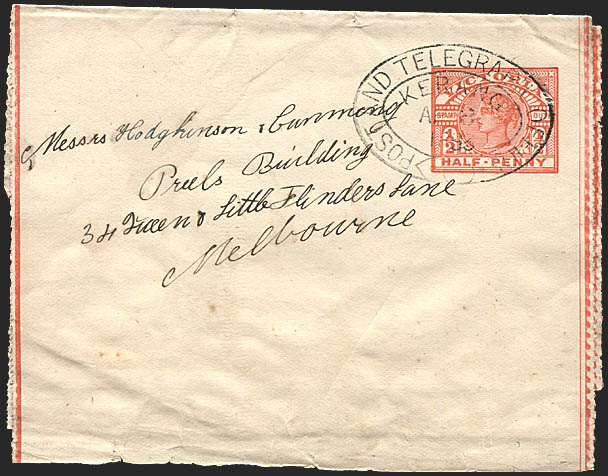 8 April 1893. |
| 2 May 1893: latest recorded use of a Kerang Belt & Buckle.
A 1 hole Kerang Belt & Buckle date stamp used in black as an arrival backstamp on a Letter Card sent from Swan Hill.
|
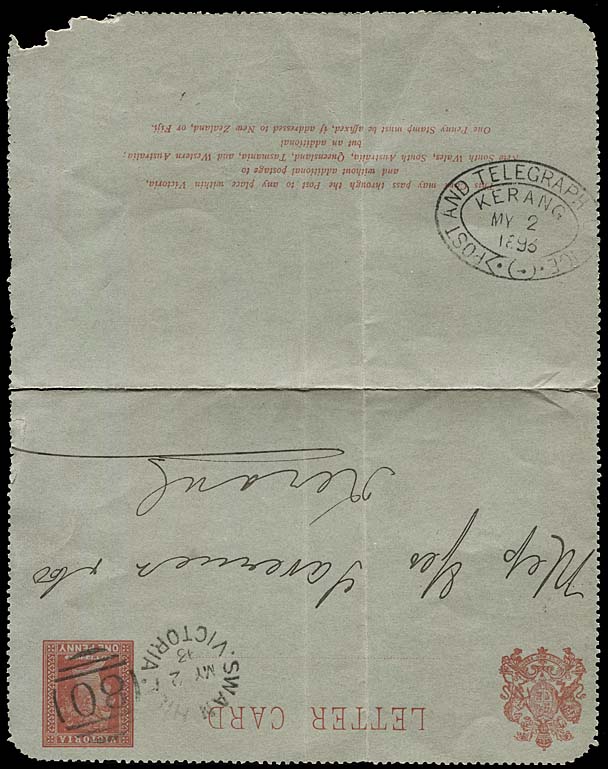 |
| Additional examples of usage. | 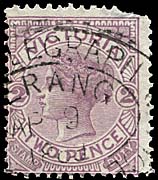 9 April 1899. |
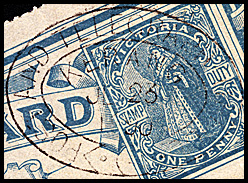 23 July 1890. Used on 1½d letter card for local delivery. |
| A rectangular TELEGRAPH OFFICE date stamp (RRH1-TO) was also used at Kerang:
|
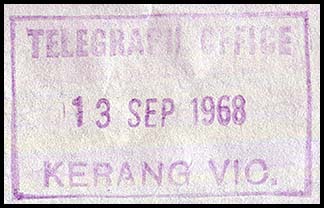 13 September 1968. |
|
| Usual postal date stamp also used on telegrams. | 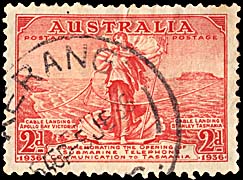 5 June 1936.
|
| Kyneton.
The Telegraph Office was opened in April 1857. The Post Office had changed its name from Mount Macedon on 1 January 1854. |
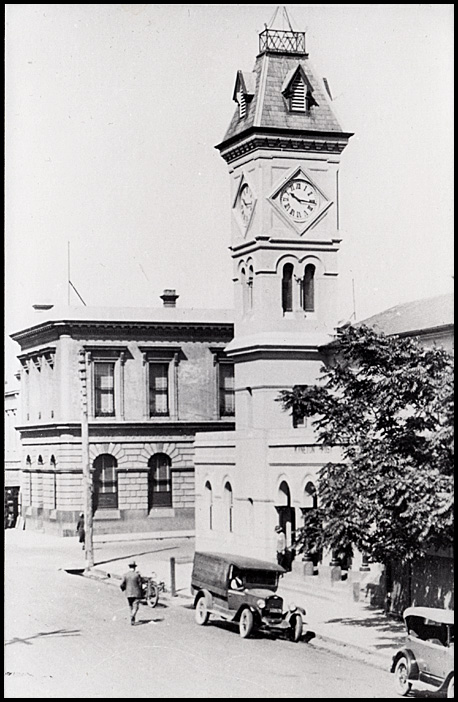 Kyneton Post & Telegraph Office about 1920. |
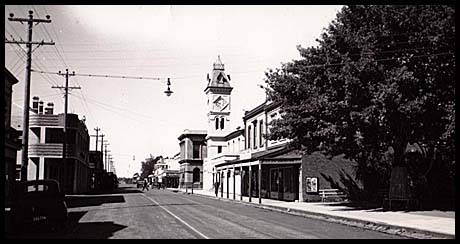 Looking towards the Post & Telegraph Office. |
|
The following types of date stamps were issued to the Kyneton Office:
|
|
|
|
|
|
| The usual postal date stamps were also used on telegrams: |  10 August 1897. Unframed date stamp used on |
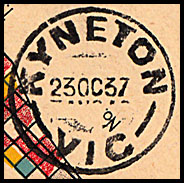 23 October 1937. 2 long arcs. |
The Argus of 23 May 1864 reported on the honesty of the Telegraph Messenger as follows:
|
|
|
A 2 hole Belt & Buckle date stamp was used at the Post & Telegraph Office.
|
|
|
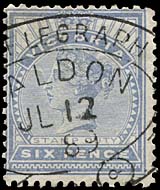 12 July 1889. |
 29 July 1893 |
|
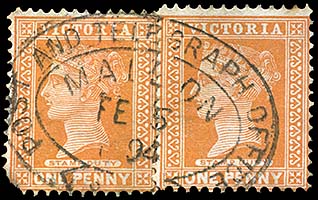
5 February 1894. (latest recorded date). |
||
|
|
|
|
The Telegraph Office opened in October 1865. A Telegraph Office was also opened at the Railway Station in 1889 but later closed. It was reopened about 1910 and closed about 1916. |
|
Merbein is next to Mildura. |
|
The Office was issued with a rubber oval Telegraph Office at some stage.
|
 14 March 1989. Archival strike. |
| Mildura.
The Telegraph Office opened
|
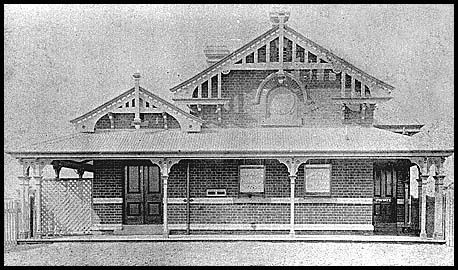 Mildura Post & Telegraph Office 1890. |
|
| The Office was issued with five types of rubber date stamp for use with telegrams: | ||
|
|
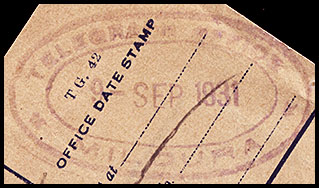 9 September 1931. Used on AB-DO-8A. |
|
 |
|
|
 26 November 1959. |
|
|
||
|
 28 February 1963. |
|
|
|
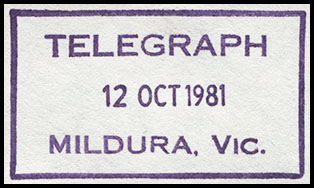 12 October 1981. |
In addition, the usual postal date stamps were used on telegrams: |
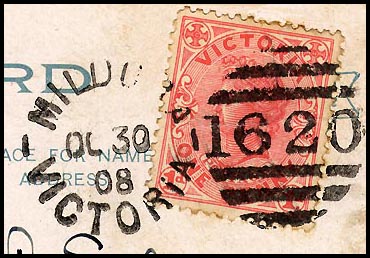 Mildura duplex with date stamp and barred numeral 1620. 30 October 1908. |
 Mildura - usual postal date stamp. 11 August 1923. Diameter: 26 mm. |
| Mincha.
The Mincha Railway Station changed name to Mincha in 1902. The office closed on 1 April 1977. |
|||
A T.O. Mincha date stamp is recorded:
|
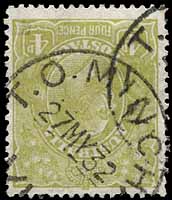 27 May 1932. Earliest recorded date. |
 26 October 1933. |
 23 April 1952. |
 17 April 1959. Rare on cover. |
|
A Receiving Office was established at Bumbong about 1924. It was renamed Robinvale on 1 August 1924. It was then upgraded to a Post Office on 14 July 1926. It has Euston as its sister City which is located on the other side of the Murray River in New South Wales. |
| No special date stamp was used for telegrams. Instead the usual Post Office date stamp was used. |
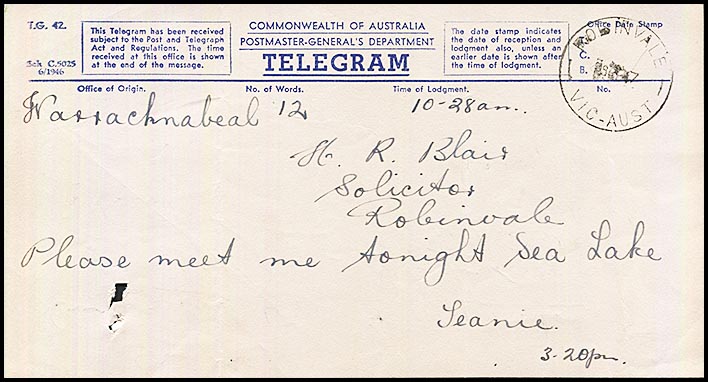 Unclear date - used in 1947. |
| Serpentine (Creek).
The Telegraph Office was opened in September 1873. The town was established as Serpentine Creek in 1863 and the Post Office was opened in 1868, In 1917, the name was changed to Serpentine.
|
|
|
The Telegraph Office was opened in April 1863.
Two date stamps were issued to Swan Hill for use with telegraphic matters: |
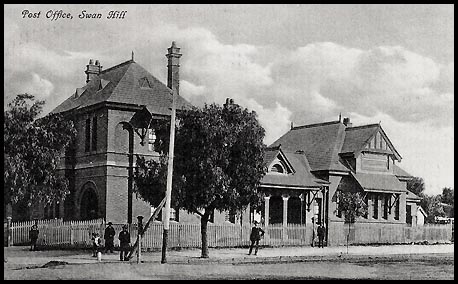 Swan Hill Post & Telegraph Office about 1900. |
||||
|
|
||||
|
 5 September 1984. |
||||
|
The Telegraph Office opened on 30 November 1861.
|
The Office was issued with a 1-hole Belt & Buckle date stamp.
|
 4 July 1887 - earliest recorded date. |
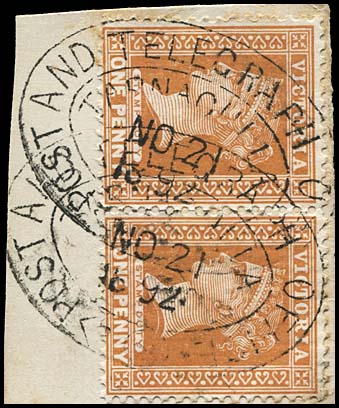 21 November 1892. |
 4 May 1892 on a pair of 1d brown Naish design. |
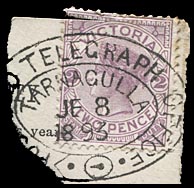 8 June 1893 |
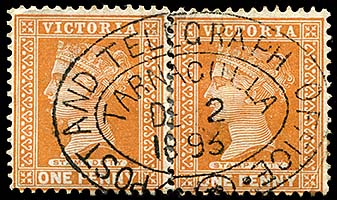 2 December 1893 - latest recorded date. |
|
| Tragowel.
Tragowel is south of Kerang. The Telegraph Office was opened in May 1878 while the Post Office was opened in June 1878. It closed on 3 November 1976. |
||
The office was issued with a T. O. Tragowel date stamp:
|
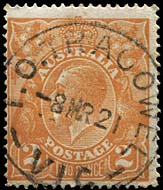 8 March 1921. |
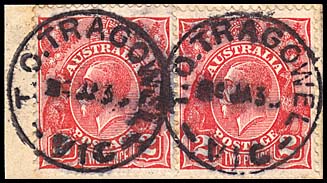 January 193? |
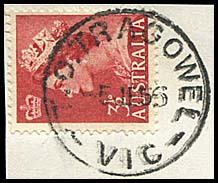 5 June 1956. |
|
|

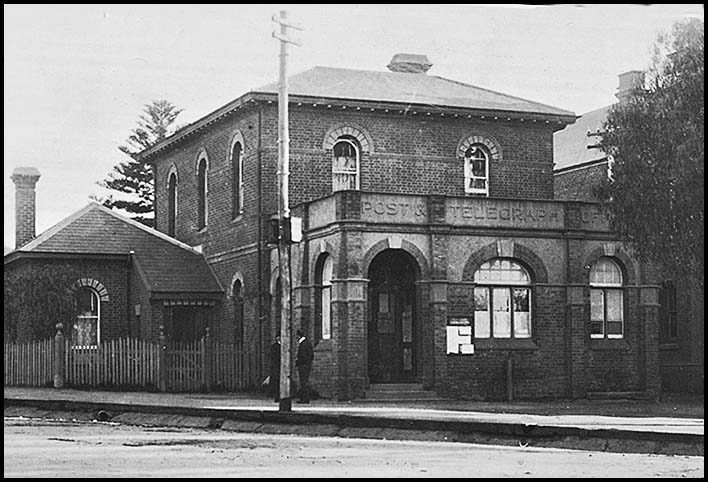
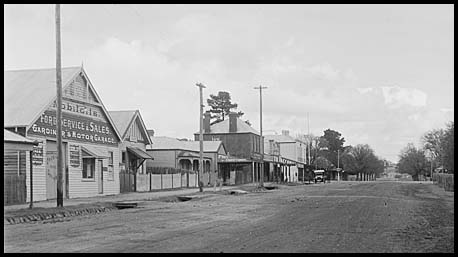
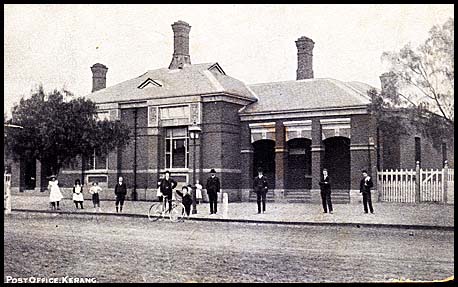

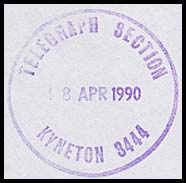
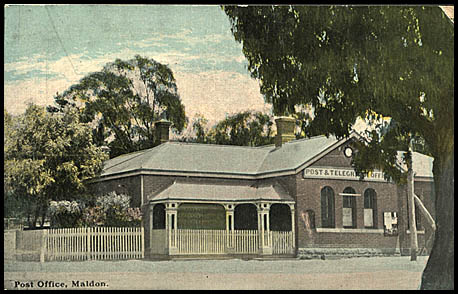
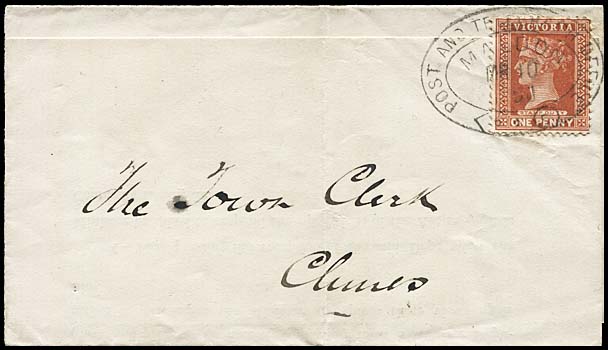



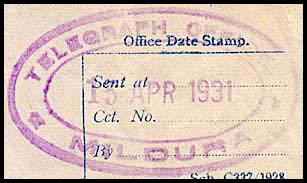

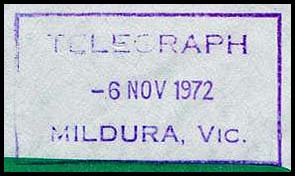
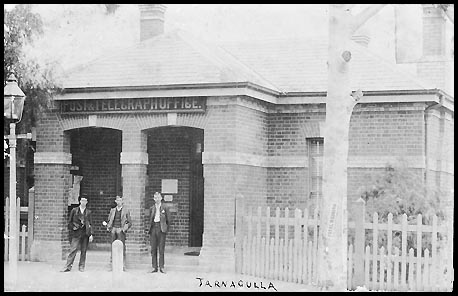 Tarnagulla Post and Telegraph Office about 1900.
Tarnagulla Post and Telegraph Office about 1900.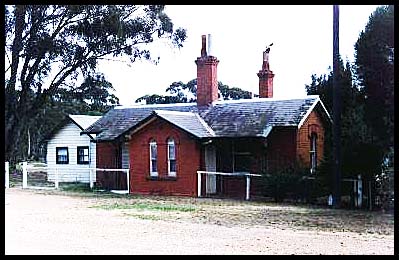 Tarnagulla Post and Telegraph Office - modern photograph.
Tarnagulla Post and Telegraph Office - modern photograph.